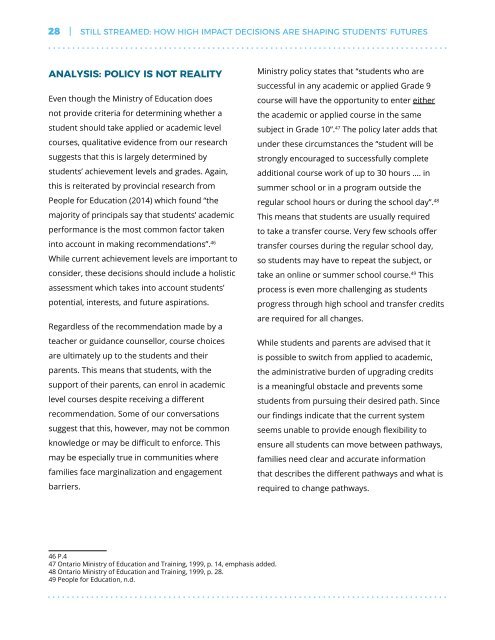Streaming_Report-September-v1.1-web
You also want an ePaper? Increase the reach of your titles
YUMPU automatically turns print PDFs into web optimized ePapers that Google loves.
28 | STILL STREAMED: HOW HIGH IMPACT DECISIONS ARE SHAPING STUDENTS’ FUTURES<br />
ANALYSIS: POLICY IS NOT REALITY<br />
Even though the Ministry of Education does<br />
not provide criteria for determining whether a<br />
student should take applied or academic level<br />
courses, qualitative evidence from our research<br />
suggests that this is largely determined by<br />
students’ achievement levels and grades. Again,<br />
this is reiterated by provincial research from<br />
People for Education (2014) which found “the<br />
majority of principals say that students’ academic<br />
performance is the most common factor taken<br />
into account in making recommendations”. 46<br />
While current achievement levels are important to<br />
consider, these decisions should include a holistic<br />
assessment which takes into account students’<br />
potential, interests, and future aspirations.<br />
Regardless of the recommendation made by a<br />
teacher or guidance counsellor, course choices<br />
are ultimately up to the students and their<br />
parents. This means that students, with the<br />
support of their parents, can enrol in academic<br />
level courses despite receiving a different<br />
recommendation. Some of our conversations<br />
suggest that this, however, may not be common<br />
knowledge or may be difficult to enforce. This<br />
may be especially true in communities where<br />
families face marginalization and engagement<br />
barriers.<br />
Ministry policy states that “students who are<br />
successful in any academic or applied Grade 9<br />
course will have the opportunity to enter either<br />
the academic or applied course in the same<br />
subject in Grade 10”. 47 The policy later adds that<br />
under these circumstances the “student will be<br />
strongly encouraged to successfully complete<br />
additional course work of up to 30 hours …. in<br />
summer school or in a program outside the<br />
regular school hours or during the school day”. 48<br />
This means that students are usually required<br />
to take a transfer course. Very few schools offer<br />
transfer courses during the regular school day,<br />
so students may have to repeat the subject, or<br />
take an online or summer school course. 49 This<br />
process is even more challenging as students<br />
progress through high school and transfer credits<br />
are required for all changes.<br />
While students and parents are advised that it<br />
is possible to switch from applied to academic,<br />
the administrative burden of upgrading credits<br />
is a meaningful obstacle and prevents some<br />
students from pursuing their desired path. Since<br />
our findings indicate that the current system<br />
seems unable to provide enough flexibility to<br />
ensure all students can move between pathways,<br />
families need clear and accurate information<br />
that describes the different pathways and what is<br />
required to change pathways.<br />
46 P.4<br />
47 Ontario Ministry of Education and Training, 1999, p. 14, emphasis added.<br />
48 Ontario Ministry of Education and Training, 1999, p. 28.<br />
49 People for Education, n.d.

















